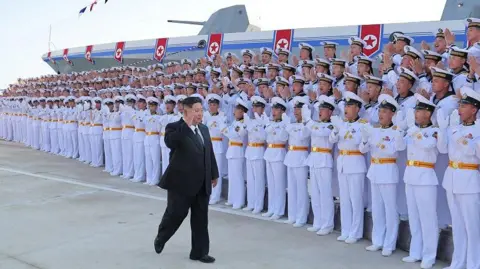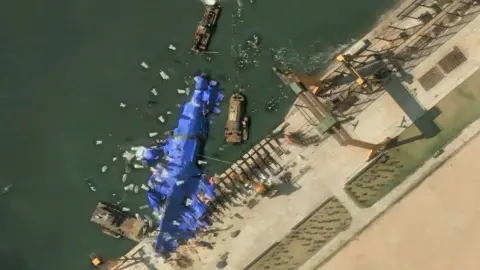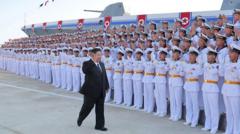What the capsizing and relaunching of a warship tells us about North Korea’s regime
Jean Mackenzie
Seoul correspondent
Reporting fromSeoul

 KCNA via Reuters
KCNA via Reuters
When North Korea’s new warship capsized into the sea during its launch last month, it made international headlines. News organisations followed every development, from its successful refloating to its relaunch last Friday.
But why such interest, given there were no casualties, and the damage to the hull appeared relatively minor?
The intrigue has less to do with the failure itself and more with how Kim Jong Un reacted.
Kim immediately denounced the failure as “a criminal act” that “could not be tolerated”, saying it had damaged the country’s “dignity”. He ordered that the ship be restored immediately, and those responsible be punished. Four party officials were subsequently arrested.
This furious outburst, followed by the ship’s swift repair, teaches us a lot about the North Korean regime, whose moves are often so difficult to decipher.
First, it reveals how serious North Korea is about building a nuclear-armed navy.
Despite having a nuclear arsenal, which is growing in size and sophistication, and an enormous standing army, North Korea’s navy is considered greatly inferior to those of its enemies – South Korea, Japan and the United States – who have some of the most powerful naval fleets in the world.
“Kim Jong Un believes nuclear weapons are the only way he can protect his country, and yet all it has at sea is an old submarine and some small support ships,” said Choi Il, a retired South Korean navy captain.
Therefore, almost since the start of his reign, Kim has prioritised building a modern and powerful navy, equipped with nuclear weapons.
This warship is a key first step towards this goal. It is one of two destroyers North Korea has built over the past year, the first of which launched successfully in April. Weighing 5,000 tonnes, they are by far the biggest warships North Korea has, and are capable, in theory, of firing nuclear short-range missiles.

 Maxar Technologies via Getty Images
Maxar Technologies via Getty Images
According to Mr Choi, who now heads South Korea’s Submarine Research Institute, it is extremely rare for a destroyer of this class to capsize during its construction and launch, given the advanced technology required to build one.
This would therefore have been “a very embarrassing incident” for Kim Jong Un, he said, as it “highlights the limitations of North Korea’s shipbuilding”.
Worse still, this flagship project failed in front of his eyes. Kim was attending the ship’s launch ceremony, along with his daughter and a crowd of spectators.
“North Korea is obsessed with showing off. I imagine they were planning a whole series of performances, so of course Kim couldn’t help but be furious”, Mr Choi added.
But experts in North Korea propaganda believe there is far more to Kim Jong Un’s outburst than raw anger and humiliation.
Choosing to publicise the capsizing in the way he did was a deliberate political strategy, they say, and shows Kim is shifting away from the regime’s tendency to conceal unpleasant truths.
Rachel Minyoung Lee from the Washington-based Stimson Centre, who has analysed North Korean propaganda for decades, explained how this has become a core pillar of Kim’s propaganda strategy.
Before Kim came to power, and even in the early years of his rule, the regime would hide anything negative as a way to control the narrative.
But as information has started to spread more freely in North Korea, it has become harder to cover up such major incidents.
“The leadership decided it was almost silly to try and hide what people already knew, and much more effective to show people they were dealing with problems,” Ms Lee said.
“Now, when there’s a problem, you publicise it, you call out those responsible, and demonstrate to people that if you don’t do your job, you will be held accountable. And in doing so, you let everyone know that the government and the leadership are doing their jobs well”.
In the case of the warship, this strategy appears to have worked remarkably effectively. The repairs were completed ahead of schedule, in just over three weeks, defying the expectations of naval experts.
“The rapid relaunch shows how even a failure can be turned into a political success,” said Kim Dong-yup, an assistant professor at the University of North Korean Studies in Seoul.

 KCNA via Reuters
KCNA via Reuters
But he and others say Kim has used this incident not just to project success but to strengthen people’s loyalty to the regime and its ideology – another consistent feature of his rule.
The ship capsized as it was launched sideways from the dock into the sea – a complicated maritime manoeuvre – and part of the bow got stuck on the launching ramp. But rather than present this as a technical failure, Kim Jong Un claimed the incident was caused by “absolute carelessness and irresponsibility.”
In contrast, he praised a worker who died during the ship’s construction, for “putting his blood and sweat” into the project.
“They turned his death into a symbol of devotion, to strengthen people’s loyalty,” said Professor Kim Dong-yup.
Rather than present Kim Jong Un as an infallible god as was the case for his father and grandfather, they elevated the loyal worker, he said. “This is a big shift in North Korea’s governing technique and shows Kim Jong Un’s astonishing ability to adapt and control the narrative”.
The biggest takeaway for Ms Lee, the propaganda expert, is that “the North Koreans achieve whatever they set out to do.”
“They set this goal of having a nuclear armed navy, and now they’re demonstrating they’re on their way to achieving that”.
No-one thought they could build the destroyers in just over a year, or repair this damage in less than a month, but they have, Ms Lee added, much like they did with their nuclear and missile programme despite the world’s initial scepticism.
The retired navy captain Mr Choi agreed. “People may look at this episode and laugh, and think ‘oh, North Korea is so far behind’, but they’re making significant progress”, he said.
Most concerning, say he and others, is that Kim Jong Un is intent on transforming his navy from one that is limited to patrolling its own seas into one that will be able to sail the world’s oceans and launch pre-emptive nuclear strikes.
“We must be vigilant and prepare accordingly,” he said.
Additional reporting by Hosu Lee and Leehyun Choi.







